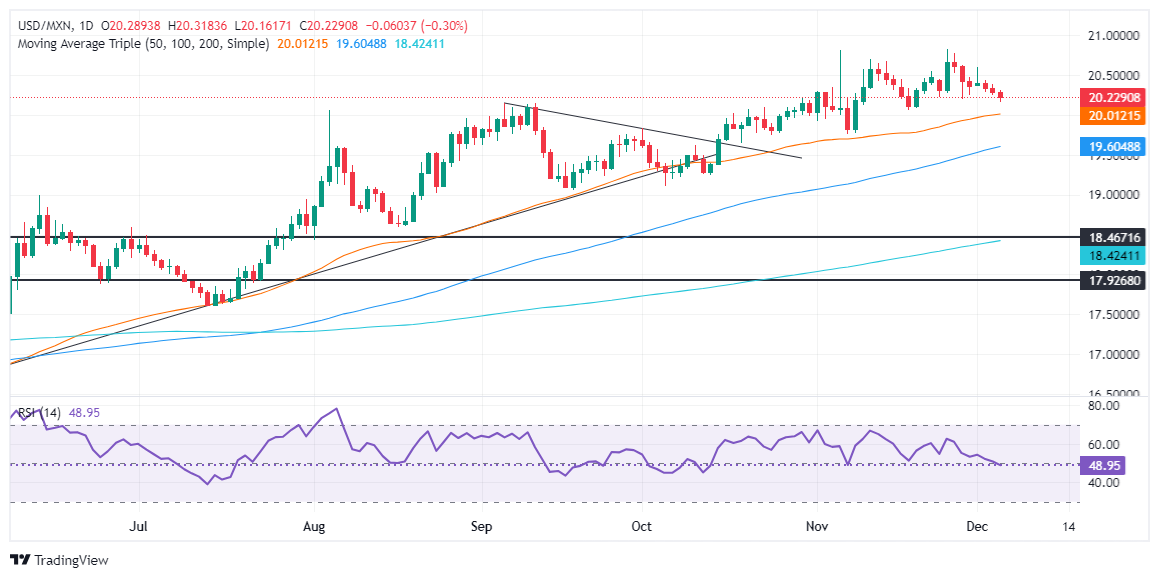- Mexican Peso extends uptrend, appreciating 0.49% despite hawkish tones from Fed Chair Powell.
- Banxico's Deputy Governor comments on potential inflation pressures from a proposed minimum wage hike.
- US economic indicators show a mixed picture with jobless claims rising and a narrowing trade deficit.
The Mexican Peso extends its winning streak to three consecutive days and appreciates against the US Dollar following the release of weak US jobs data. Traders shrugged off hawkish comments by Federal Reserve (Fed) Chair Jerome Powell, which failed to boost the Greenback. The USD/MXN trades at 20.18, down 0.49%.
Mexico’s economic schedule remains absent, yet Irene Espinosa, Deputy Governor of the Bank of Mexico (Banxico), crossed the wires. She said approving a 12% increase in the minimum wage for 2025 would exert upward pressure on inflation. Espinosa added that she remains open regarding the December 19 monetary policy decision, adding that she would assess whether core inflation continues its downward trend and services inflation remains below 5%.
In the US, the Department of Labor reported that Initial Jobless Claims for the week ending November 30 exceeded forecasts, hinting at a slight deterioration of the jobs market. Other data revealed that October’s trade deficit narrowed, according to the US Bureau of Economic Analysis.
On Wednesday, Powell indicated that the US economy's recent strength allows the Fed to proceed cautiously with interest rate cuts. He noted that the balance between their dual mandate — maximum employment and stable prices — is currently well-aligned, suggesting no urgency for rate reductions.
Ahead this week, Mexico’s schedule will feature the release of automobile production data. The docket will feature Fed speakers and Nonfarm Payrolls (NFP) figures in the US.
Daily digest market movers: Mexican Peso rallies as US Dollar tumbles
- The latest Citi Mexico survey showed that most economists estimate Banxico will cut rates by 25 basis points at the December meeting. Analysts project the economy will grow 1.5% in 2024 and 1% in 2025.
- The US Department of Labor reported that Initial Jobless Claims rose by 9K to 224K for the week ending November 30, exceeding the forecast of 215K. The 4-week moving average reached 218.3K.
- The US Bureau of Economic Analysis announced that October's trade deficit narrowed significantly to $73.8 billion, down from $83.8 billion in September.
- The CME FedWatch Tool suggests that investors see a 70% chance of a 25-basis-point (bps) rate cut at the Fed’s December meeting.
- Data from the Chicago Board of Trade, via the December fed funds rate futures contract, shows investors estimate 19 bps of Fed easing by the end of 2024.
- Banxico’s November survey shows that analysts estimate inflation at 4.42% in 2024 and 3.84% in 2025. Underlying inflation figures will remain at 3.69% in 2024 and 2025. GDP is forecasted at 1.55% and 1.23% for 2024 and 2025, respectively, and the USD/MXN exchange rate at 20.22 for the rest of the year and 20.71 in 2025.
- Fed speakers crossed the newswires. St. Louis Fed President Alberto Musalem said that time might be near to slow or pause rate cuts. Richmond Fed’s Thomas Barkin said that risks for inflation and maximum employment remain balanced.
Mexican Peso technical outlook: USD/MXN drops below 20.30 on Peso’s strength
The USD/MXN has fallen for the third consecutive day and isn’t finding acceptance near the 20.50 figure. In the short term, momentum shifted slightly bearish, with the Relative Strength Index (RSI) piercing below its neutral line. Therefore, the exotic pair might test the 20.00 figure.
If sellers push the exchange rate below the November 19 low of 20.06, the 20.00 mark would be up for grabs. If cleared, the pair will extend its downtrend, challenging the 50-day Simple Moving Average (SMA) at 19.99. A breach of the latter will expose the 100-day SMA at 19.61 before the psychological 19.00 figure.
Conversely, key resistance levels would be exposed if USD/MXN climbs past 20.50. Up next is the year-to-date peak at 20.82, followed by the 21.00 mark. On further strength, the pair will challenge the March 8, 2022 peak at 21.46, followed by the November 26, 2021 high at 22.15.
Mexican Peso FAQs
The Mexican Peso (MXN) is the most traded currency among its Latin American peers. Its value is broadly determined by the performance of the Mexican economy, the country’s central bank’s policy, the amount of foreign investment in the country and even the levels of remittances sent by Mexicans who live abroad, particularly in the United States. Geopolitical trends can also move MXN: for example, the process of nearshoring – or the decision by some firms to relocate manufacturing capacity and supply chains closer to their home countries – is also seen as a catalyst for the Mexican currency as the country is considered a key manufacturing hub in the American continent. Another catalyst for MXN is Oil prices as Mexico is a key exporter of the commodity.
The main objective of Mexico’s central bank, also known as Banxico, is to maintain inflation at low and stable levels (at or close to its target of 3%, the midpoint in a tolerance band of between 2% and 4%). To this end, the bank sets an appropriate level of interest rates. When inflation is too high, Banxico will attempt to tame it by raising interest rates, making it more expensive for households and businesses to borrow money, thus cooling demand and the overall economy. Higher interest rates are generally positive for the Mexican Peso (MXN) as they lead to higher yields, making the country a more attractive place for investors. On the contrary, lower interest rates tend to weaken MXN.
Macroeconomic data releases are key to assess the state of the economy and can have an impact on the Mexican Peso (MXN) valuation. A strong Mexican economy, based on high economic growth, low unemployment and high confidence is good for MXN. Not only does it attract more foreign investment but it may encourage the Bank of Mexico (Banxico) to increase interest rates, particularly if this strength comes together with elevated inflation. However, if economic data is weak, MXN is likely to depreciate.
As an emerging-market currency, the Mexican Peso (MXN) tends to strive during risk-on periods, or when investors perceive that broader market risks are low and thus are eager to engage with investments that carry a higher risk. Conversely, MXN tends to weaken at times of market turbulence or economic uncertainty as investors tend to sell higher-risk assets and flee to the more-stable safe havens.
Information on these pages contains forward-looking statements that involve risks and uncertainties. Markets and instruments profiled on this page are for informational purposes only and should not in any way come across as a recommendation to buy or sell in these assets. You should do your own thorough research before making any investment decisions. FXStreet does not in any way guarantee that this information is free from mistakes, errors, or material misstatements. It also does not guarantee that this information is of a timely nature. Investing in Open Markets involves a great deal of risk, including the loss of all or a portion of your investment, as well as emotional distress. All risks, losses and costs associated with investing, including total loss of principal, are your responsibility. The views and opinions expressed in this article are those of the authors and do not necessarily reflect the official policy or position of FXStreet nor its advertisers. The author will not be held responsible for information that is found at the end of links posted on this page.
If not otherwise explicitly mentioned in the body of the article, at the time of writing, the author has no position in any stock mentioned in this article and no business relationship with any company mentioned. The author has not received compensation for writing this article, other than from FXStreet.
FXStreet and the author do not provide personalized recommendations. The author makes no representations as to the accuracy, completeness, or suitability of this information. FXStreet and the author will not be liable for any errors, omissions or any losses, injuries or damages arising from this information and its display or use. Errors and omissions excepted.
The author and FXStreet are not registered investment advisors and nothing in this article is intended to be investment advice.
Recommended content
Editors’ Picks

AUD/USD ticks lower toward 0.6200 after Australian Nov inflation data
AUD/USD remains pressured toward 0.6200 following the release of Australian consumer inflation figures, which showed a slowing in the trimmed mean annual CPI , boosting the odds for an April RBA rate cut. Meanwhile, US-China trade war fears and a softer risk tone add to the weight on the pair.

USD/JPY steadies at around 158.00, Fed Minutes awaited
USD/JPY holds steady at atound the 158.00 mark early Wednesday amid uncertainty over further BoJ rate hikes. Further, the Fed's hawkish shift, the recent surge in the US bond yields and a bullish US Dollar support the currency pair, though Trump trade risks cap gains. US ADP data and Fed Minutes eyed.

Gold consolidates near $2,650 amid mixed cues; looks to Fed Minutes
Gold price stabilizes near $2,650 after the pullback from the $2,665 barrier as concerns about Trump's tariff plans and geopolitical risks support the safe-haven bullion. That said, diminishing odds for further Fed rate cuts and elevated US Treasury bond yields-led US Dollar strength weigh on Gold price ahead of Fed Minutes.

Top 3 Price Prediction Bitcoin, Ethereum, Ripple: Over $560 million in liquidation
Bitcoin hovers around $97,000 on Wednesday after declining more than 5% the previous day. Ethereum and Ripple follow in BTC’s footsteps and decline 8.3% and 6.15% respectively.

Five fundamentals for the week: Nonfarm Payrolls to keep traders on edge in first full week of 2025 Premium
Did the US economy enjoy a strong finish to 2024? That is the question in the first full week of trading in 2025. The all-important NFP stand out, but a look at the Federal Reserve and the Chinese economy is also of interest.

Best Forex Brokers with Low Spreads
VERIFIED Low spreads are crucial for reducing trading costs. Explore top Forex brokers offering competitive spreads and high leverage. Compare options for EUR/USD, GBP/USD, USD/JPY, and Gold.
